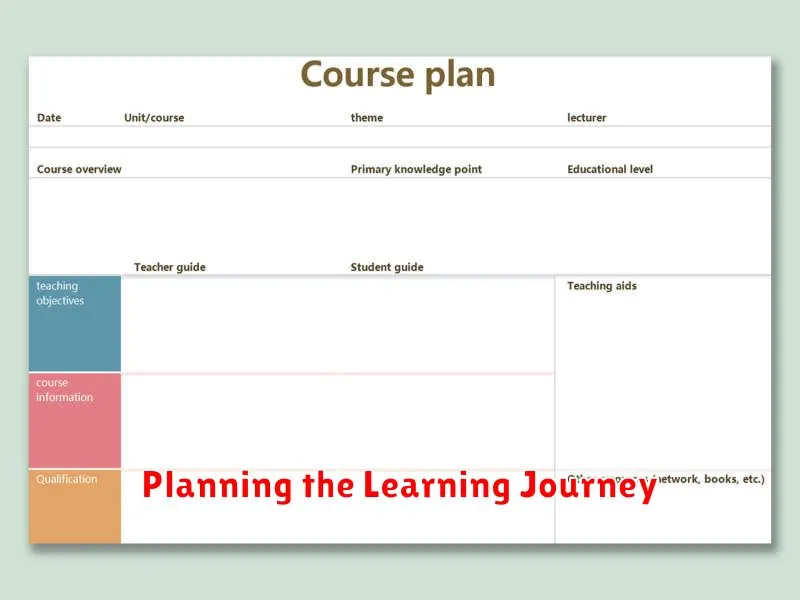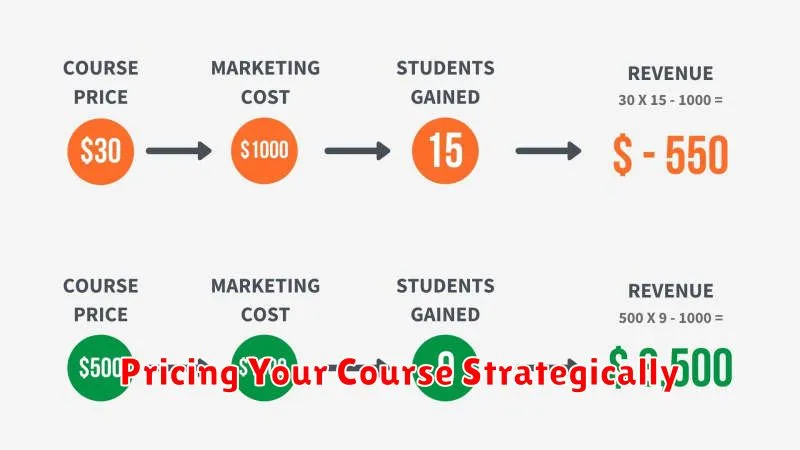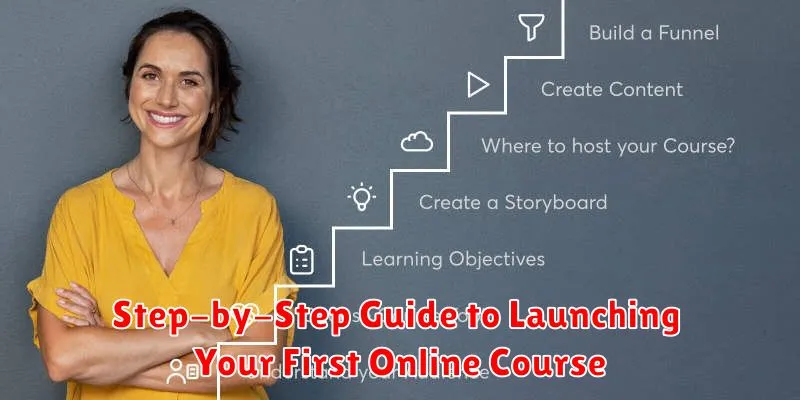Creating and launching your first online course can feel like a daunting task. Where do you even begin? This step-by-step guide breaks down the entire process into manageable pieces, providing you with the essential knowledge and practical tools to launch a successful online course. Whether you’re an expert in digital marketing, creative writing, or software development, this guide will equip you with the strategies you need to share your expertise with the world and build a thriving online learning community.
From identifying your target audience and choosing the right course platform to creating compelling course content and effective marketing strategies, this guide will cover every essential step. Learn how to structure your course, record high-quality videos, and engage your students for maximum impact. We’ll also delve into pricing strategies, launching your course effectively, and building a long-term sustainable online course business. Start your journey to becoming a successful online course creator today!
Why Online Courses Are a Great Business Model
Online courses present a compelling business model due to their scalability and low overhead. Once a course is created, it can be sold to an unlimited number of students without significantly increasing production costs. This differs dramatically from traditional brick-and-mortar businesses where growth often requires substantial investment in physical space, personnel, and inventory. Furthermore, online courses can generate passive income, allowing creators to earn revenue even while not actively teaching or marketing.
The digital nature of online courses offers immense flexibility for both creators and students. Creators can work from anywhere in the world and set their own schedules, while students can learn at their own pace and access materials from any location with an internet connection. This accessibility expands the potential market beyond geographical limitations, reaching a global audience and fostering a broader community of learners. Additionally, online courses provide the opportunity for continuous improvement. Creators can update and refine their content based on student feedback and evolving industry trends, ensuring the course remains relevant and valuable over time.
Beyond the financial benefits, online courses offer impactful opportunities for entrepreneurs to share their expertise and make a difference. By teaching valuable skills and knowledge, course creators empower individuals to advance their careers, pursue their passions, and achieve personal growth. This ability to contribute to the development of others can be a deeply rewarding aspect of the online course business model, driving creators to continuously innovate and provide high-quality educational experiences.
Planning the Learning Journey

A well-structured learning journey begins with a clear understanding of the desired outcome. Defining specific and measurable learning objectives is crucial. These objectives should outline the knowledge, skills, and abilities learners are expected to acquire. A thorough needs assessment helps identify existing knowledge gaps and tailor the learning experience accordingly. This initial planning phase lays the foundation for a successful and impactful learning journey.
Once the objectives are established, the next step involves designing the learning path. Choosing the right learning methodologies is essential. Consider a blend of approaches such as lectures, hands-on activities, group discussions, and online modules to cater to diverse learning styles. The chosen methodologies should align with the learning objectives and create an engaging and effective learning experience. Structuring the content logically and incorporating opportunities for practice and feedback further enhances learning.
Finally, ongoing evaluation and refinement are vital throughout the learning journey. Regular assessments measure learner progress and identify areas where adjustments are needed. Collecting feedback from learners provides valuable insights into the effectiveness of the learning program. This iterative process of evaluation and refinement ensures that the learning journey remains relevant, engaging, and ultimately achieves its intended goals.
Choosing the Right Topic Based on Demand
Selecting a topic based on demand requires careful consideration of current trends and audience interests. Analyzing market data, including search volume and social media engagement, can provide valuable insights into what topics are resonating with people. Understanding these trends can help ensure your content is relevant and reaches the widest possible audience, maximizing its impact.
Beyond simply identifying popular topics, it’s crucial to assess the level of competition. A high-demand topic might also have a high volume of existing content. Consider exploring niche areas within broader topics to reduce competition and establish yourself as an authority in a more specific area. This strategic approach allows you to target a dedicated audience and potentially achieve greater visibility.
Finally, aligning demand with your own expertise and passion is essential for long-term success. While chasing trends can provide short-term gains, genuine interest in a topic will sustain your efforts and enhance the quality of your content. This combination of market demand, strategic niche selection, and personal investment will ultimately contribute to creating valuable and engaging content.
Outlining Modules and Lessons
A well-structured course relies on a clear outline of modules and lessons. Each module should represent a key topic or theme, encompassing several related lessons. For example, a module on “Project Management” might contain lessons on planning, execution, and closure. This modular approach allows learners to grasp the subject matter in manageable segments, fostering a deeper understanding of the overall curriculum.
Individual lessons within each module should be focused on specific learning objectives. These objectives define the skills and knowledge learners should acquire after completing the lesson. Clear objectives not only guide instruction but also facilitate assessment by providing measurable outcomes. Each lesson should contain concise and engaging content, utilizing various methods such as lectures, readings, activities, and assessments to promote effective learning.
The overall structure should be logical and progressive, building upon previously learned concepts. This ensures a coherent learning experience where learners can connect the dots between different modules and lessons, reinforcing their understanding of the broader subject matter.
Recording High-Quality Content on a Budget

Creating compelling content doesn’t require breaking the bank. By focusing on a few key areas, you can significantly improve the quality of your recordings without expensive equipment. Audio is arguably the most important element. Invest in a decent, affordable microphone and prioritize recording in a quiet environment to minimize background noise. Software like Audacity, which is free, can help with editing and noise reduction. For video, good lighting is essential. Natural light is your best option, but affordable LED panels can supplement or replace it effectively. Finally, consider your background. A clean, uncluttered space is best, and a simple backdrop can be easily created with inexpensive materials.
Smartphones are surprisingly powerful content creation tools. Modern phone cameras are capable of recording high-definition video, and numerous apps offer advanced features like stabilization and color correction. Remember to clean your lens and use a tripod or stable surface for steady shots. External lenses and microphones designed for smartphones can further enhance quality at a relatively low cost. When editing, free or low-cost software options like mobile versions of InShot or CapCut can be powerful allies.
Ultimately, planning and preparation are your greatest assets. A well-written script or outline will keep your content focused and engaging. Practice your delivery to minimize mistakes and re-recordings. By focusing on these fundamentals, you can produce high-quality content that connects with your audience without emptying your wallet.
Hosting Platforms Comparison
Choosing the right hosting platform depends on your specific needs and technical expertise. Shared hosting is the most affordable option, ideal for beginners and small websites with limited traffic. Resources are shared amongst multiple users on a single server, which can sometimes impact performance. VPS (Virtual Private Server) hosting offers more control and resources, providing a dedicated portion of a server. This is a good middle ground for growing websites with moderate traffic and those needing more customization.
Dedicated hosting gives you an entire server to yourself, offering maximum control, performance, and security. This is the most expensive option, best suited for large websites with high traffic and demanding resource needs. Cloud hosting distributes your website across multiple servers, ensuring high availability and scalability. It’s a flexible option, allowing you to pay only for the resources you use.
Consider factors like cost, performance requirements, technical skills, and scalability needs when making your decision. Researching different providers within each category is also crucial, as features and pricing can vary significantly.
Pricing Your Course Strategically

Pricing your online course requires careful consideration of several factors. Value is paramount. Think about the transformation your students will experience and the benefits they’ll gain. Research your target audience to understand their budget and willingness to pay. Analyze your competitors’ pricing, not to copy them, but to understand the market landscape. Factor in your own costs, including marketing, platform fees, and your time investment, to ensure profitability. Ultimately, the right price balances perceived value with market dynamics.
Consider different pricing models. A one-time purchase offers simplicity. A subscription model can generate recurring revenue and foster a community. Tiered pricing allows you to offer different levels of access and content at varying price points. You could also offer payment plans to make your course more accessible. Choosing the right model depends on your course content, target audience, and business goals.
Don’t be afraid to experiment and adjust your pricing. Regularly review and analyze your sales data. Gather feedback from your students. A/B testing different price points can provide valuable insights. Pricing is an ongoing process, and finding the optimal price for your course may require some fine-tuning.
Pre-Launch Marketing Essentials
Pre-launch marketing is crucial for building anticipation and generating early interest in your product or service. Defining your target audience is the first essential step. Understanding their needs, preferences, and online behavior allows you to tailor your messaging and choose the right marketing channels. Market research plays a vital role in this process, providing valuable insights into competitor analysis and market trends. This foundational work informs a strong value proposition, which clearly communicates the benefits and unique selling points of your offering.
Building a pre-launch buzz requires a multi-faceted approach. Creating a landing page to capture leads and offer exclusive pre-launch content is a great starting point. Leveraging social media platforms to engage with potential customers and build a community around your brand is also essential. Consider running early bird discounts or contests to incentivize sign-ups and generate excitement. Influencer marketing can be a powerful tool for reaching a wider audience and building credibility.
Finally, measuring and analyzing your pre-launch marketing efforts is key to optimizing your campaign. Track key metrics such as website traffic, social media engagement, and lead generation. This data will help you identify what’s working and what needs improvement, allowing you to make adjustments and ensure a successful product launch.
Launch Day Checklist
Confirm all systems are operational. This includes verifying server stability, database connections, API integrations, and third-party services. Test core functionalities end-to-end, paying particular attention to user authentication, payment processing (if applicable), and critical workflows. Ensure monitoring tools are correctly configured and actively tracking key performance indicators. Address any outstanding bugs or issues immediately. Have your support team briefed and ready to handle user inquiries.
Communicate launch details to your audience. Send out planned announcements through email, social media, or other appropriate channels. Prepare documentation and FAQs to address common questions and concerns. Monitor social media and community forums for feedback and early reports of problems. Be responsive and transparent in your communications. Have a plan in place for handling unexpected issues or negative feedback.
Celebrate your team’s hard work and dedication. Launching a product is a significant achievement. Acknowledge everyone’s contribution and take a moment to appreciate the milestone. Reflect on the launch process and identify areas for improvement in future releases. Begin gathering user feedback and data to inform future development. Start planning for post-launch updates and improvements.
Support and Updates After Launch
We are committed to providing ongoing support and updates after the launch of our product. This includes addressing any bugs or technical issues that may arise, as well as implementing improvements based on user feedback. Our goal is to ensure a smooth and positive user experience. We will provide regular updates and communicate any significant changes or planned maintenance.
Technical support will be available through email and our online help center. Our support team will respond to inquiries promptly and strive to resolve issues efficiently. We also plan to release regular updates to enhance functionality, add new features, and improve performance. The frequency of these updates will depend on various factors, including user feedback and development priorities.
We believe in continuous improvement and value your input. We encourage you to share your feedback and suggestions with us so we can continue to refine and enhance our product to best meet your needs. We are dedicated to providing a high-quality product and excellent support to our users.

